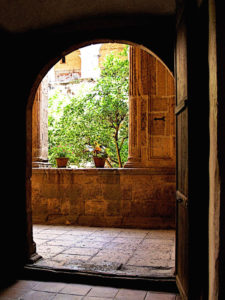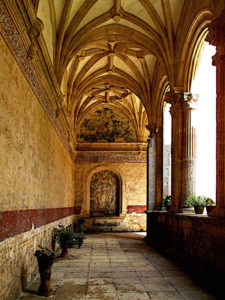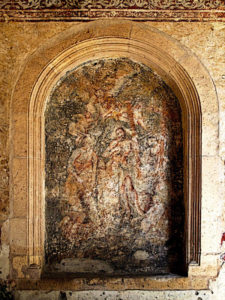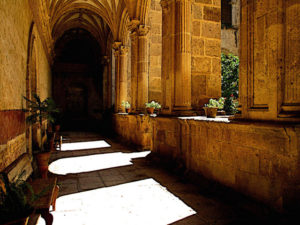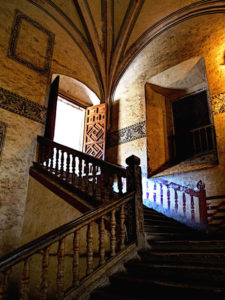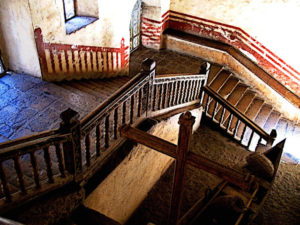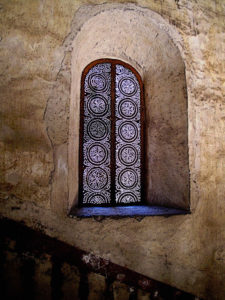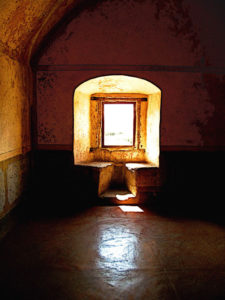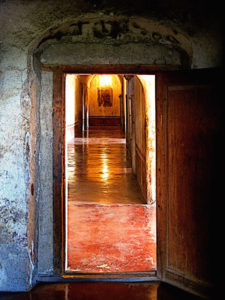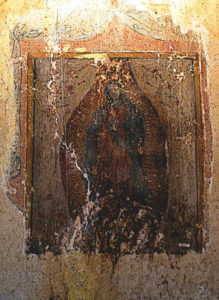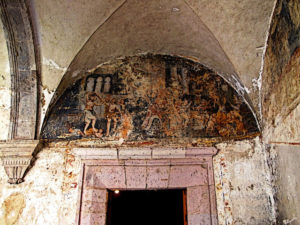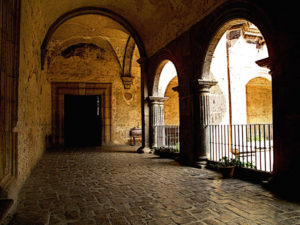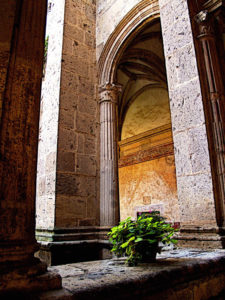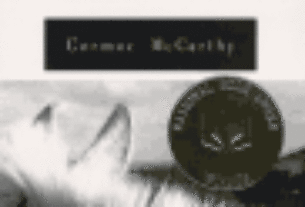It was a chance thing, really. We were heading for Patzcuaro, almost due south of Guanajuato where we had spent the past several days on a photography and business junket. While we were checking out of our small hotel just this side of the tunnels that snake under old Guanajuato, the otherwise taciturn gentleman who owned the establishment told us — almost as an afterthought — that, well, if we were heading for Patzcuaro, we might want to take lunch in Yuriria because there was a very old and beautiful convent that we could visit.
Intrigued, but facing a rather longish driving day, Tracey and I were ambivalent about the idea of taking time away from the journey and jeopardizing our planned arrival in Patzcuaro before dark. So, when the exit sign for Yuriria appeared several hours later, we hesitated for a moment too long and missed the turn.
Sailing down the road at a fast clip, it seemed a momentary impossibility to retrace our steps. Hesitation, then decision, and more than a little laughter, as Tracey hit the brakes, came to an abrupt stop at the side of the narrow two-lane highway, and made a U-turn in the middle of the road. Moments later, we were driving down a dusty road into what looked like a backwater farming town in central Mexico.
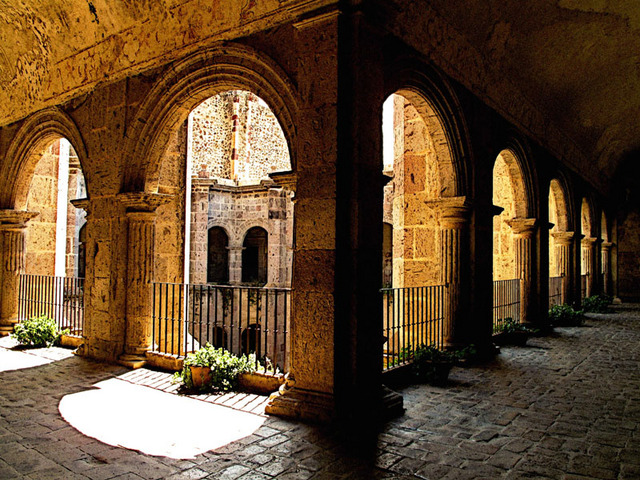
A long time ago, Yuriria was an important center in the area. Also known as Yuririapundaro — a name which means “Lake of Blood” in the Purepecha language, a reference to the lake waters that turn red during seismic events — the town became an administrative center and stop-off point on the “silver highway” that connected Mexico City with Guanajuato and Zacatecas. Mine owners were required to register their holdings with the Spanish crown but, as more and more silver mines were discovered, administrative centers were opened at points closer to the new locations, and Yuriria gradually lost its prominence. These days, Yuriria is home to only 26,000 people with 90,000 or so living in the surrounding area.
The Ex-Convento de San Pablo Apostol is easy to find — it dominates the town’s humble skyline. After parking the car, we walked the few short sunny blocks through the little town’s center towards the edifice. Families were Saturday-promenading in the park, balloon vendors were sailing their colors, and the small market was bustling with a lunch-time crowd.
Yuriria’s Ex-Convento is among the largest in Mexico and resembles, as do many ex-convents, a medieval fortress. For us, “convent” meant that this must have been a place of women, but in fact, the Ex-Convento was a monastery. The word convent finds its origins in the Latin words con and venire, meaning “to come together;” it was a word commonly used in Spanish to refer to such a place occupied by either a society of men or women.
Its resemblance to a fortress is no accident. As a result of the Spanish settlements during the mid-1500s, the area became a war zone with ongoing clashes between the local people and the Spanish Crown. Conventos were erected all over Mexico as the Catholic Church engaged in evangelization and pacification, actively supported in its efforts by the colonial government. By the end of the 16th century, only 75 years after the Conquest, there were 400 monasteries in Mexico; almost half of them were built by the Franciscans, with the Dominicans and Augustinians nearly tied for second place. It has been estimated that 9 million native people were converted as early as 1543.
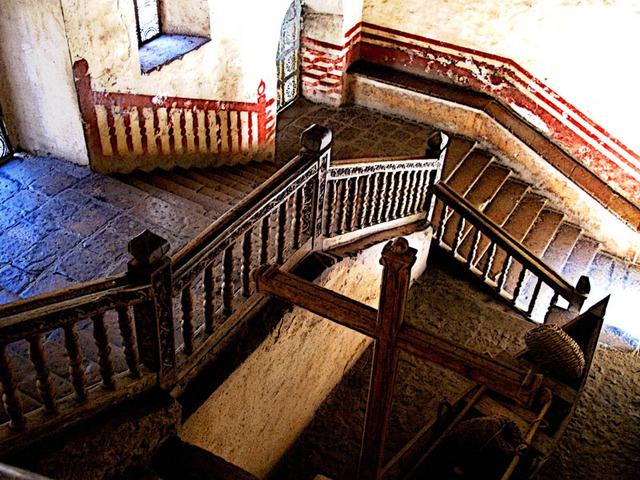
The religious orders in Mexico tended to be regional with the Franciscans working in central and northern Mexico as well as the Yucatan; the Dominicans could be found mainly in the southern regions of Oaxaca and Chiapas; and the Augustinians worked in the states of Hidalgo, Morelos, Guanajuato and Michoacan. The Ex-Convento in Yuriria is an Augustinian invention; the monastery was founded by Friar Alonso de la Veracruz, who had professed as an Augustinian in 1537 shortly after his arrival in Mexico. Formerly an instructor at the prestigious University of Salamanca in Spain, Veracruz has been considered one of the outstanding scholars and intellectuals in 16th century Mexico and has been credited with the founding of the University of Mexico.
Construction on the Convento San Pablo Apostol began in 1550 and was completed in 1559 (though some date the completion to 1567). Its erection and lay-out were overseen by Fray Diego de Chavez, nephew of the famously cruel conquistador Don Pedro de Alvarado. While only a few records exist of professional architects working in Mexico during this era, and most convents and churches were conceived by local friars with little — if any — formal training, the architect responsible for the plan of Yuriria’s convent is known to be the renowned Pedro del Toro. (It’s thought that Del Toro and De Chavez also worked together at nearby Cuitzeo in Michoacan on the construction of the Santa Maria Magdalena Convent.) The construction force consisted of nearly 40 masons, both Hispanic and indigenous, and more than 300 Indian laborers. Rock was transported some ten miles from Cerro de la Cantera, about ten miles distant from Yuriria.
Today, one enters the Ex-Convento through a portico embraced by large graceful arches, disappearing at first into the cool shadows of the porteria, or porter’s room, then emerging into the walkway that surrounds the verdant and tranquil central courtyard. On the day of our visit, we were nearly completely alone, save for the fellow who oversaw the entrance and two other employees who quietly lingered in the passageways. We passed only a handful of other visitors. The convent consists of two levels, with common rooms below and former living quarters above. Entrance to the rooms is via surrounding Gothic arcades, whose graceful arches overlook the courtyard and provide shade to the entryways of the building’s many rooms.
We began by walking slowly around the lower level’s arcade, our pace slowed by the magnificence of the place and the redolence of its history and significance. Decorations are sparse, possibly because of the devastating fire of 1814 which destroyed much of the town itself and the convent’s religious artwork. We could see the remnants of once-spectacular murals that graced most of the entrances leading from the arcades into the inner hallways. The staircase that rises from the main level to the floor above gave us much pause. The stairway is still astonishing after nearly five centuries, and we ascended slowly and in solitude, pausing to revel in the metal filigree windows and the illusionistic handrails that are painted on the walls.
On the second floor, we continued our slow apprehension of the convent, wandering from one quiet room to the next, with the gloom of corners alleviated by bands of sunshine pouring in through each room’s single window. Long dark hallways gave way to brilliant sunlight at their terminuses and through occasional oculi above. Our mood was reverent and contemplative, perhaps evoked by the atmosphere of the place, a disposition that seemed to exist in the air as a result of all the events that had taken place here so many years ago. The moment that truly took our breath away, though, was when we came upon Her, the Virgin of Guadalupe. At the end of a very long hallway, illuminated today by only one bare low wattage bulb, and though the ravages of the centuries have taken their toll, she still glows on the wall with a presence that is palpable and wonderful.
At the time of the Spanish Conquest, which began in 1519 with the arrival of Hernan Cortes, the native populations were estimated at between 15 and 30 million. By the end of that same century, numbers had dwindled to only about 2 million. Smallpox, famine, severe labor conditions in the silver mines, and plagues all contributed to the genocide. The encomienda system is of particular note; a Spanish institution that dates from the second voyage of Columbus in 1493, the encomienda was a legal system that allocated groups of Indians to privileged colonists. The colonists were entitled by the Spanish Crown to extract tribute and labor from their designated Indians, and were required in turn to attend to their Christian welfare. Tremendous advantages were taken by the colonists, making it impossible for the native people to look after their own needs.
Friar Alonso de la Veracruz, the founder of the Convento de San Pablo Apostol, believed that the native peoples of Mexico had the right to dominion over their land, labor and tribute, a right that was inherent in their communities and could not be taken by force. Given the beliefs of Veracruz, one can hope and imagine that life around the convent in the 1500s was perhaps a little less harsh than it might have otherwise been.
We left the Ex-Convento reluctantly, in the late afternoon, with the long road to Patzcuaro still ahead of us. Before departing, we paused for an early dinner in the restaurant of what appeared to be the only hotel in town and enjoyed the hospitality of the townspeople, a very lively mariachi band, and possibly the country’s largest molcajetes. And we reflected on our extraordinary good luck of this chance encounter with Yuriria’s Ex-Convento, thanks to the brief remarks of our Guanajuato host and a quick U-turn on a narrow highway.
Such is traveling, such is Mexico.
These images are available from Olden Mexico.

